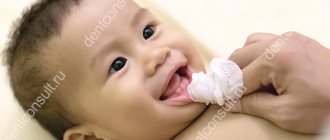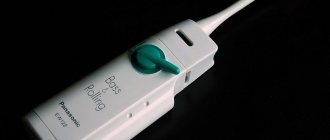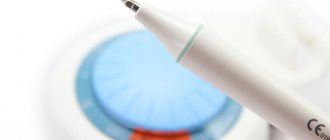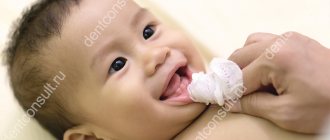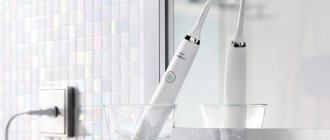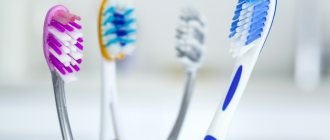Strong teeth are the key to good health of the whole body for many years, so it is very important from the very first tooth to teach your child how to care for them using a toothbrush and suitable toothpaste. At the same time, starting from the age of 2.5-3 years, a child can be offered an electric toothbrush - more interesting, unusual and equipped with additional functions.
How to choose an electric toothbrush for small but very important family members – we’ll figure it out in our article.
Peculiarities
The special thing about an electric toothbrush is that its bristles vibrate. Therefore, you do not need to make an effort to clean all your teeth well. The bristles of the brush move up and down or in a circle, effectively removing plaque and food particles from between teeth.
This device consists of a handle with a motor inside, a power source and a barrel on which a removable head is attached. Unlike adult toothbrushes, which are used by all family members, children's toothbrushes are different. They have the following features:
- operate at low speed;
- they are smaller and lighter;
- the handle is shorter;
- decorated colorfully, often in the form of fairy-tale characters;
- the head has the shape of a corolla;
- the villi are short and very soft, but elastic.
Attention! If a child wears braces, the shape of the head should be different: the bristles are arranged in one bunch to make it easier to clean the space between them and the teeth.
| Name | Age limit | Type | Prices RUR |
| From 1 year | |||
| CS Medica CS-561 Kids | from 1 year to 5 years | sound | from 611 to 1693 |
| Hapica Baby | from 1 year to 6 years | sound | from 1340 to 1890 |
| From 3 years | |||
| Oral-B Pro 500 + Stages Power Frozen | from 3 years old | standard | from 3410 to 5790 |
| Oral-B Pro 500 + Stages Power Star Wars | from 3 years old | standard | from 3410 to 4098 |
| Hapica Kids | from 3 to 10 years | sound | from 1209 to 1890 |
| Oral-B Kids Mickey Mouse | from 3 years | standard | from 1700 to 3590 |
| Philips Sonicare For Kids HX6322/04 | from 3 years | sound | from 4830 to 6788 |
| Oral-B Smart 4 | from 3 years old | standard | from 4340 to 11990 |
| Oral-B Stages Power Frozen Elsa, Anna, Olaf D12.513K | from 3 years old | standard | from 1174 to 4990 |
| From 4 years | |||
| Soocas C1 | from 4 years old | sound | from 2079 to 2990 |
| From 5 years | |||
| CS Medica CS-461 Kids | from 5 to 12 years | standard | from 300 to 1162 |
| CS Medica CS-562 Junior | from 5 years old | sound | from 792 to 1490 |
| FOREO ISSA mini 2 | from 5 years old | sound | from 8990 to 9999 |
| CS Medica CS-462 Kids | from 5 to 12 years | standard | from 614 to 890 |
| From 6 years | |||
| Oral-B Stages Power Star Wars D12.513K | from 6 years | standard | from 2650 to 5500 |
| Oral-B Junior | from 6 years | standard | from 2650 to 5500 |
| Oral-B Smart 4 Junior Sensi | from 6 years old | standard | from 4290 to 7990 |
| From 7 years | |||
| Philips Sonicare For Kids HX6311/07 | from 7 years | sound | from 3170 to 5491 |
Types of electric brushes
Like adult models, a children's electric toothbrush can be of several types:
- Classic. This model consists of a body with a motor and a round head with bristles. The nozzle rotates at a certain speed, removing food debris and bacterial plaque from the surface of the teeth.
- Sonic children's electric toothbrush. It doesn’t just “spin”, but oscillates, thanks to which it is possible to remove much more microbes from the surface of the enamel.
- Ultrasonic models are considered the most effective. Their action is based on the ability of ultrasound to destroy the film created by bacteria much more effectively.
Power can be supplied from a built-in battery, replaceable batteries, or from the mains. Sometimes models are produced with a base like a telephone. By installing the product in the groove, you ensure its charging.
Brushes have different operating modes. Everyone has a standard one, but some models offer variety. For example, there may be modes for cleaning the tongue, or adapted for teeth with increased sensitivity. If your child has white spots or other enamel problems, it is better to use gentler cleaning methods. There are even separate modes designed to massage the gums, clean the tongue, and the inner surface of the cheeks. The number of brush operation options is individual for each model.
The more expensive and modern such a device is, the more capabilities it has. These also include a sleep timer, built-in melodies and other useful functions.
Some buyers think that it just depends on the brand. In reality the situation is completely different. For example, a toothbrush for children from the famous brand Braun Oral-B called Stages Power regularly finds itself in various ratings, taking good places. At the same time, it is universal and is intended for use by children from 3 to 12 years old; it has only one operating mode. Moreover, it has one non-removable attachment. That is, this product is disposable, and after three to four months of use you will have to buy a new brush. The nozzle has an indicator that shows in color that the moment has come when the product is no longer suitable for use and will do more harm than good.
This model operates from standard AA batteries, also known as AA batteries. The set includes 1 piece. from Duracell.
However, Oral B has many “reusable” models with replaceable attachments. Among them is a popular model from the cartoon series. It can be with a pattern of “Cars”, “The Little Mermaid”, Mickey Mouse”, “Frozen”, “Cinderella”, “Snow White”.
For older children, Oral-B Stages Power “Star Wars” and an analogue from the “Avengers” series are produced. So you can easily find a design and capabilities to suit any request.
Kinds
Dentists recommend starting to brush your baby's teeth when they just start to erupt. And at 2-3 years old he can already buy an electric toothbrush. There are many different models on sale, parents are often confused. They may differ in the principle of action and type of movement. In addition, children's toothbrushes vary in the age of the child and the softness of the bristles.
According to the operating principle
All electric toothbrushes are powered by a motor. But their operating principle may be different.
- Standard models are the most affordable. They have a round head that can rotate at different speeds and in different directions. They gently cleanse teeth without damaging gums.
- Sonic ones work due to sound waves, which cause the fibers to vibrate and whip up foam from the paste. They better clean plaque, bacteria and food debris from all hard-to-reach places. This option is recommended for a child who wears a plate or braces.
- Ultrasonic models work on the same principle, only at higher sound vibrations. They are considered the most effective, since ultrasound destroys even hard plaque. Not recommended for use by children before teeth change. They are used mainly to remove tartar and darkening of teeth.
By type of movement
Brushes also differ in the type of head movement. It can rotate or pulsate, that is, move back and forth. There are also models that combine these functions, which increases cleaning efficiency.
- With a brush with a rotating head, teeth are cleaned by moving the bristles in a circle. Usually the head does not rotate in one direction, but back and forth. For a child, you need to choose a brush with a low rotation speed, this will prevent injury.
- More effective models are those in which the head not only rotates, but also vibrates. It cleans better and damages your gums less.
- In pulsating brushes, the bristles produce forward movements, due to which they penetrate between the teeth. They soften and remove plaque better.
Types of electric brushes: which ones are suitable for children
The classification of dental care devices is common to everyone – both children and adults. However, not every gadget is suitable for a baby. Therefore, we will further consider those options that are approved for use in children.
Read on the topic: how to choose a good electric toothbrush for an adult - all types of popular devices in one detailed material.
- Classic model. The operation of a standard (or classic) device is based on the action of a miniature motor that drives the brush head. The bristles move back and forth or in a circle (and back) at a given speed, cleaning out food debris and plaque.
- Sound type. These models have a built-in generator, thanks to which the brush head emits high-frequency sound vibrations. They destroy deposits on enamel with greater efficiency and promote better formation of foam from toothpaste, which washes out even the smallest impurities well. Children can use such a brush, but under the supervision of adults and always under the supervision of a doctor - it is important to understand that sound waves do not cause harm.
- Ultrasonic type. The head of such a brush does not just move, the device produces ultrasonic waves that destroy dirt and germs. The frequency of ultrasound is about 40-50 thousand vibrations per minute. Therefore, such models are contraindicated for children, since the effect of ultrasound is detrimental to fragile enamel; it quickly destroys areas with weak mineralization.
Advantages
When mechanically brushing your teeth, you need to make certain movements with the brush. To clean all dental surfaces you need to work for at least 2 minutes. Children often don't like this. And the main advantage of an electric toothbrush is that the correct movements are programmed into it; you just need to move it along the dentition. This process attracts the baby, turning oral care into an interesting game.
Such devices also have other advantages:
- provide complete oral care with minimal effort;
- thoroughly clean the interdental spaces, which a child cannot do with a regular brush;
- prevent the development of caries;
- can be used without toothpaste
Attention! A child familiar with an electric toothbrush is less afraid of dental treatment.
Contraindications for using the device
Dentists name several main factors when the use of an electric toothbrush by a child is contraindicated:
- the presence of wedge-shaped defects: we are talking about depressions that appear at the base of the tooth and can increase over time, exposing the neck. Intense mechanical impact contributes to the development of this pathology,
- bottle caries: it occurs in babies who are often fed milk, formula, or foods containing a lot of sugar (including juices, cookies) before bedtime. Leftover food is an ideal breeding ground for microbes that destroy enamel. As a result, first whitish, then brownish spots appear on the enamel layer. These areas should not be subjected to strong pressure, otherwise the situation will worsen,
- high rate of enamel abrasion: occurs quite often in children. The cause may be an incorrect bite or a not well-studied disease such as bruxism (grinding teeth during sleep), as well as heredity and fragility of enamel caused by various diseases,
- the presence of areas of enamel with low mineralization: white spots - the first harbingers of caries. If a child experiences such phenomena, an electric brush is contraindicated for him. First you need to undergo a remineralization course, otherwise the device will do more harm than good,
- Gum disease: Another reason to put off using a powered device. Even soft stubble can aggravate inflammation, so the first step is to get rid of the troublesome ailments.
Terms of use
Children under 5-7 years old must use such devices under adult supervision. First, the parents themselves brush the baby’s teeth, then they just stay nearby.
The cleaning process differs from the usual mechanical one. You need to place the rotating head on one area at an angle of 45˚. Hold it without pressing for 10 seconds, then move it a little. It is necessary to pay attention to all surfaces, not forgetting the chewing, distant teeth, from the inside.
Attention! Children are recommended to use this brush no more than 2 times a week.
How to use
Before first use, rinse the brush with clean water, and do the same after each cleaning session. After applying a specialized baby paste to the moving head, you can begin the procedure:
- press the Power button;
- bring the instrument to the surface of the front teeth of the upper jaw, hold for a few seconds;
- sequentially treat the inner and outer sides, as well as the chewing surface of the upper jaw dentition;
- do the same manipulations with the lower jaw;
- rinse your mouth;
- Rinse the brush under the tap.
The unsuitability of the attachments is indicated by colored bristles, which begin to discolor after a month of constant use. As soon as their shade becomes unnoticeable, it’s time to change your toothbrush.
Useful features
Such devices have various useful functions. It is best to use them after 7 years of age; children need to learn how to simply brush their teeth. Useful features may include:
- It’s good if the brush has a timer that will help the child brush his teeth as much as needed;
- a pressure sensor is required; it is triggered when the child presses the head hard against the teeth;
- The gum massage mode is useful, which improves blood circulation;
- There may be different replaceable attachments: for sensitive gums, cleaning interdental spaces, gentle cleaning.
Is one electric brush enough to teach a child how to brush their teeth properly?
How to teach a child to brush his teeth?
Until the age of seven, dentists recommend the most active participation of parents in the process of brushing teeth, and after seven years - only passive.
Even teenagers are strongly advised to supervise when and how they brush their teeth. After purchasing an electric toy for your child, you can be sure that his delight will know no bounds. However, if the baby does not take brushing his teeth for granted, an electric toy will not be able to correct the situation for a long time. Gradually, the joy of novelty will pass, the electric brush will take its place next to the regular one, and they will have to be bored together. This is, firstly.
Secondly, you can teach a person to brush their teeth correctly with a regular brush only by instilling this skill from childhood, then it will be useless. Think about why we teach children to draw with a pencil first, despite the fact that we can immediately start teaching them to type and draw on a computer. Thirdly, brushing teeth with a regular hand brush helps develop a child's manual skills, and, as any teacher knows, a child's mind is at his fingertips. Brushing your teeth with a regular brush will thus provide additional exercise for the mind.
Popular brands
Children's electric brushes are produced by many companies. But you need to give preference to proven well-known brands. They engage in research and implement new technologies, so they produce high-quality products.
Oral-B
The most popular models are produced under this brand. They are easy to use, inexpensive, and have a timer that teaches your baby to brush their teeth for a certain time. All brushes are beautifully designed and have a comfortable non-slip handle.
Philips
The brushes are produced with a bright design, the handle is decorated with drawings of your favorite cartoon characters. The head is oval, standard size. The devices have a timer, a cleaning mode, and Bluetooth.
CS Medica
The company has developed a bright design especially for children. The operating principle is based on sound vibrations. Can be used from 2-3 years. Has backlight, timer, low weight.
Hapika
This Japanese brand produces different models for children from 3 years old. They have a small head with soft, rounded bristles. Hapika brushes create sound vibrations that gently clean children's teeth. They are light and do not make much noise.
From what age
The enamel of baby’s temporary crowns has a rather fragile structure that can be easily damaged..
For this reason, most dentists recommend replacing a regular toothbrush with an electric model no earlier than age three.
But some manufacturers of this type of device have a different opinion. That's why children's oral care shelves display electric toothbrushes that can be used from birth.
Be that as it may, the product should be purchased in accordance with the age of the child. In addition, experts recommend that parents monitor the cleaning process until the age of 7.
Incorrect movements of a child when caring for the oral cavity can provoke the emergence of many unwanted problems.
How to choose
The child needs to purchase a separate brush, specially made for children. In addition, when choosing, you need to pay attention to several parameters:
- It is better to have a charge indicator, then the device will not turn off unexpectedly;
- the child does not need many modes and additional functions;
- the handle should be comfortable and non-slip.
From one year to 3 years
Dentists recommend purchasing such a brush for a child as early as 2-3 years old, when all the teeth have grown. Another condition for its effective use is that the baby should not be afraid of the buzzing sound that it makes when working. When choosing, you need to pay attention to the labeling; the age must be indicated. A brush for such a baby should be small, light, with soft bristles. This can be recognized by the inscription extra soft.
From 3 years to 5 years
Typically, it is at this age that a child is first given an electric toothbrush. It will make it easier to get him used to brushing his teeth, as it will be perceived as a game. It is recommended to choose standard models with a small head and soft bristles; they will be marked extra soft.
From 5 years to 7 years
At this age, the child begins to use this brush more often. It may be larger in size, but still brightly decorated. You need to choose a soft head, the inscription will be soft.
From 7 years
Children over 7 years old are allowed to use these brushes independently. They no longer have to choose very bright models, since they are used to caring for their oral cavity every day. But the brush should still be light, with a soft head.
What is a children's electric brush?
You can find three types of electric brushes:
- Ultrasonic, in which the main role is given to ultrasonic waves.
- Sonic, where sound waves are designed to remove plaque.
- Mechanical.
A children's electric toothbrush should belong to the third type. Such products are an ergonomic small-sized handle-body with a built-in motor. The bristles of the electric brush perform reciprocal rotational movements or finely vibrate vertically.
Why is a mechanical brush a priority?
For young users, it is preferable to choose mechanical electric toothbrushes, since children's tooth enamel is immature and thin, and high-frequency vibrations can damage it. If you have any doubts when choosing a particular brush, dentists advise paying attention to the age parameters indicated by the manufacturer on the packaging.
To clean children's teeth, the world's leading companies offer the most gentle sonic or ultrasonic versions of brushes; children's products are always marked with the word Kids.
Power supplies
Some electric brushes are equipped with a built-in battery, and some have transformers. But the best option for children is a battery-powered toothbrush. The batteries are located in the handle housing and are reliably protected from water.
Reviews
Parents' reviews of such devices are positive. They especially often note that it was easier for the baby to get used to oral care and brushing his teeth no longer causes problems.
Olga
I bought electric brushes for my twin children when they were 5 years old. On the advice of the dentist, I chose Oral-B. The kids liked them, now they brush their teeth without reminders. The growing molars are white and clean, there is no caries.
Marina
I bought Oral-B for my daughter when she was 3.5 years old. At first she was scared by the buzzing, but then she got used to it. Now he loves his brush and brushes his teeth with pleasure.
Dmitriy
I was choosing a quality brush for my son and settled on CS Medica. It was decorated beautifully, the child liked the robots. And I’m pleased that it cleans well and is convenient to use.
Electric toothbrushes help accustom your child to the unpleasant procedure of brushing teeth. If you choose the right model, it will carefully remove plaque, protect against caries and reduce toothpaste consumption.
The positive aspects of electric brushes
Not all children can brush their teeth properly, but an electric brush will effectively remove plaque from teeth and gums, regardless of the user’s skills. The advantages of the devices include:
- ease of operation;
- reducing toothpaste consumption;
- the fact that cleaning is perceived by children as fun.
Using an electric toothbrush can be presented as a game for children aged 1 year and older. Bright colors, replaceable panels, funny stickers and a soft buzzing put older children in a positive mood, and allow younger schoolchildren to cope with the fear of going to the dentist - the doctor’s buzzing instruments will no longer seem so unfamiliar and unpleasant.
Dentists' opinion
View this post on Instagram
Save so you don’t lose, and don’t forget about ❤️

